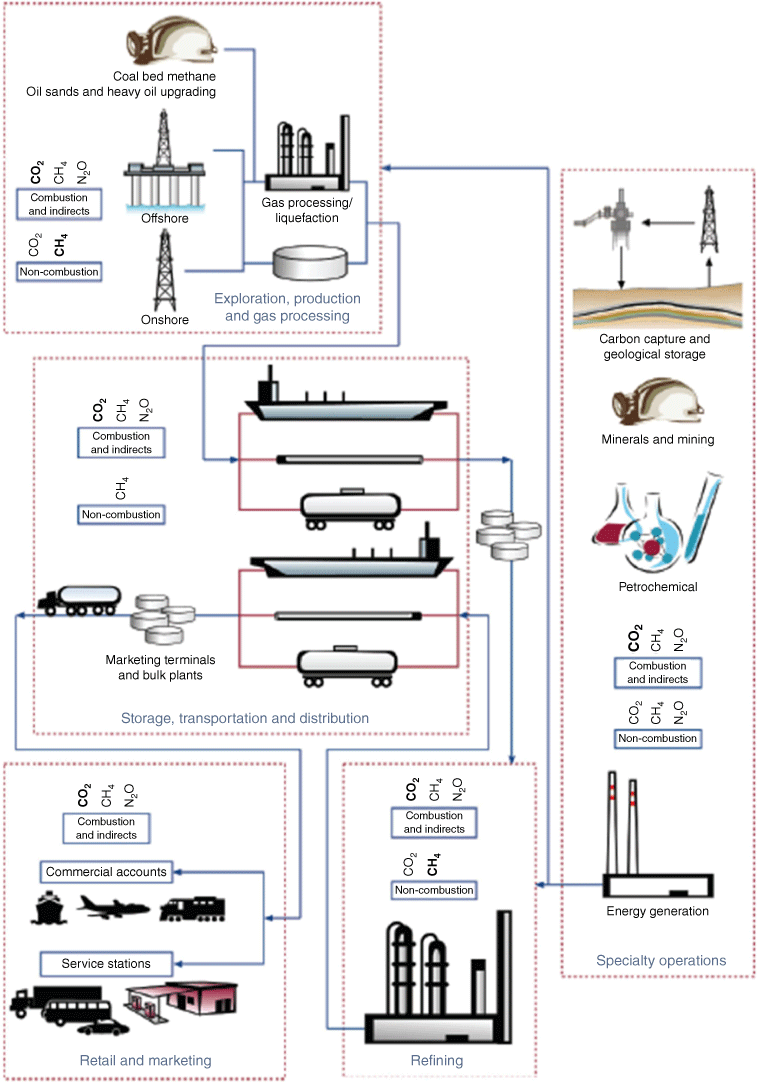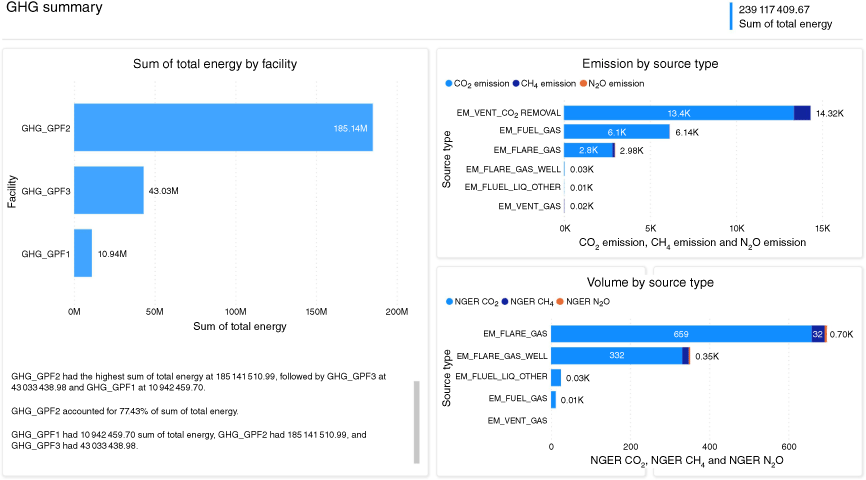Greenhouse gas emissions tracking: making it count
Fabio Terzini A * and Esther Hayes BA Elite Energy Consultants, Perth, WA, Australia.
B EnergySys Limited, Edinburgh, UK.
The APPEA Journal 63 S455-S459 https://doi.org/10.1071/AJ22207
Accepted: 20 February 2023 Published: 11 May 2023
© 2023 The Author(s) (or their employer(s)). Published by CSIRO Publishing on behalf of APPEA. This is an open access article distributed under the Creative Commons Attribution-NonCommercial-NoDerivatives 4.0 International License (CC BY-NC-ND)
Abstract
Climate change and the energy trilemma – affordability, security and sustainability – have become increasingly important concerns that affect all sectors of the economy. As governments tighten regulations in a bid to keep alive a 1.5°C pathway aligned with the Paris Agreement, the focus for many energy companies has been on addressing and complying with environmental policies, including greenhouse gas (GHG) emissions accounting and reporting. Traditionally, operators have developed tools in Microsoft Excel to perform the calculations to comply with National Greenhouse and Energy Reporting (NGER) scheme. Due to the flexibility and accessibility of Excel, these have become large, unwieldy, poorly documented and hard to maintain. In this paper, we discuss the benefits of having a Greenhouse Gas Emissions and Energy application aligned with the Production Allocation system in a centralised and structured database. Various implementations across Australia have shown that key factor such as transparency, auditability, data management and validation, as well the intrinsic relationship between production allocation and emissions, make the Production Allocation system the best place to calculate and report GHG emissions and energy.
Keywords: Clean Energy Regulator, climate change, emissions reporting, GHG, greenhouse gas emissions, hydrocarbons accounting, NGER, oil and gas, production allocation, scope 1 emissions, scope 2 emissions, scope 3 emissions.
Introduction
A key milestone on the path set by the Paris Agreement is to limit global warming. Countries have been setting new objectives for cutting greenhouse gas (GHG) emissions, as well as putting in place policies for the energy industry, and other industries, to achieve those aims.
In Australia, the schemes legislated by the Australian Government for measuring, managing, reducing or offsetting Australia’s carbon emissions are administered by the Clean Energy Regulator. There are four key schemes that are the responsibility of the Clean Energy Regulator, including the National Greenhouse and Energy Reporting (NGER) scheme, which is the focus in this paper.
The NGER scheme provides a single national framework for GHG emission, energy production and energy consumption reporting, which becomes an important data source for the Australian Energy Statistics and Australia’s National Greenhouse Accounts. The latter is required to fulfil Australia’s domestic and international GHG emissions reporting obligations under the United Nations (UN) Framework Convention on Climate Change, Kyoto Protocol and Paris Agreement (Department of Climate Change, Energy, the Environment and Water 2022).
The data supplied by the operators must comply with the Measurement Determination document, made under subsection 10(3) of the National Greenhouse and Energy Reporting Act 2007, which provides the methodology for calculating GHG emissions and energy. The Measurement Determination document covers scope 1 and scope 2 emissions and is updated annually to reflect improvements in emission estimation methods (Clean Energy Regulator 2022b). Scope 3 emissions are not reported under the NGER scheme.
The definitions of the different scopes, according to the Clean Energy Regulator (Clean Energy Regulator 2022a), are:
Scope 1 GHG emissions are the emissions released to the atmosphere as a direct result of an activity, or series of activities at a facility level. Scope 1 emissions are sometimes referred to as direct emissions.
Scope 2 GHG emissions are the emissions released to the atmosphere from the indirect consumption of an energy commodity.
Scope 3 emissions are indirect GHG emissions other than scope 2 emissions that are generated in the wider economy. They occur as a consequence of the activities of a facility, but from sources not owned or controlled by that facility’s business.
In this paper we discuss the implementation of a GHG application in EnergySys, a cloud-based low-code platform, for GHG emission and energy reporting in compliance with The National Greenhouse and Energy Reporting Act 2007 (Cth) (NGER Act). The GHG application forms part of a suite of applications developed and deployed by Elite Energy, referred to as Elite Production Management Framework (ePMF), on the EnergySys platform.
Discussion
GHG emissions consist of several sources across the oil and gas production chain, including emissions associated with exploration and development, oil and natural gas production, refining/processing, transportation/distribution, retail and marketing. Fig. 1 shows a graphical overview of the industry as well as the emissions of the primary species of GHG relevant to oil and gas operations (CH4, CO2, N2O).
Oil and gas industry GHG emissions schematic – extracted from American Petroleum Institute (2009).

The calculations performed in the GHG application are driven by the methodology outlined by the Regulator. There are four methods available to estimate GHG emissions and energy consumed or produced, as defined in the Measurement Determination (Department of Industry, Science, Energy and Resources 2008). These are:
Method 1 – The default methods are derived from the National Greenhouse Accounts methods and is based on national average estimates.
Method 2 – A facility-specific method using industry practices for sampling and Australian or equivalent standards for analysis.
Method 3 – Generally the same as Method 2 but is based on Australian or equivalent standards for both sampling and analysis.
Method 4 – Provides direct measurement of emissions by continuous or periodic emissions monitoring.
For each method, a similar, but different equation could be specified, depending on the type of emission and type of source (e.g. the equation for emissions from flaring would be different to that for venting, and the equation used for leaks would be different for wellheads to that for pipelines). For some emission types, a different method could be specified for each GHG. So assigning the calculations to each source of emission can be quite complex.
A Production Allocation (also referred to as hydrocarbon accounting) system is a centralised and structured data source that covers the entire production process of an oil and gas company. Elite Energy Consultants have implemented both the production allocation and GHG application on the EnergySys cloud platform, for various operators. This has proven to be a great place to track and report emissions and energy, due to the intrinsic relationship between the two applications.
The key reasons for the above statement are:
Integrated with the Production Allocation application. The input data to both applications overlap, and some of the inputs required for the calculation of GHG emissions are calculated as part of the allocation process. The validation of the input data as part of the complete production allocation process provides both applications with trusted data.
Emissions and energy must be reported by the operator of the facility. When operating on behalf of joint ventures and/or third parties, commercial allocation (i.e. assigning production to each company may also be installed on the same platform). The operator may wish to inform each company of their share of the emissions. So, the ownership data used for assigning production, or the results of this commercial allocation, can also be used for assigning emissions.
Storing all the validated production data, and emissions based on this validated data set provides a single source of truth for the whole company.
Fully transparent and auditable, not requiring coding knowledge. The platform provides an audit trail of changes made to values, who made them and when. It also provides screens for viewing and maintaining all values in the database, and also uses Microsoft Excel as a tool for configuring calculations, algorithms and logic rules. This makes it very easy for the user to maintain the system in a controlled and auditable fashion.
Forecast and budget data is often stored as part of ePMF to be used for reporting production against plan, and the availability of forecast and actual production and emissions gives an excellent insight into the efficiency and effectiveness of plans and processes to reduce emissions.
The GHG methodology is easily maintained in the system. The Regulator updates factors annually and the calculation methods from time to time. A lot of thought has been put into the data structure, so that when additional emission sources are introduced, factors change or different methods are selected, it is easy to do so via the screen in a controlled manner. This configuration is applied with a date range, so that data can be edited and calculations re-run retroactively, using the configuration effective for that period. For example, the Regulator made significant changes to the Measurement Determination for 2021/2022 (Compilation 13). An operator that has implemented ePMF was able to maintain the calculations and continue to use the application to meet regulatory reporting without a major overhaul of the system.
It is important to note that, traditionally, operators have developed tools in Microsoft Excel to perform the calculations to comply with NGERs. Due to the flexibility and accessibility of Excel, these have become large, unwieldly, poorly documented and hard to maintain. Excel also does not provide a audit trail of any changes made to the system. However, it does mean that the staff responsible for NGER scheme compliance have Excel skills and so find the migration to using ePMF and EnergySys easy.
Table 1 provides an example of the directly used volumes in the production allocation calculations (assuming a volumetric-based production allocation), and the volumes that are stored but not normally used in the calculations, for different types of emission sources. Furthermore, other inputs maintained and stored in the system include, but are not limited to, emission factors, compositional analysis, molar mass (ISO 6976) and Global Warming Potentials (GWP).
| Source | Quantity or activity | Volume used in PA | Volume stored in PA |
| Combustion – flare | Calculate if not metred | Y | Y |
| Combustion – gas fuel | Calculate if not metred | Y | Y |
| Combustion – liquid fuel | Calculate if not metred | Y | Y |
| Vent – cold process vent | Calculate if not metred | Y | Y |
| Visible leaks | Calculate using engineering calculations | Y | Y |
| Vents (e.g. completion) | Activity data | N | Y |
| Leakage – gathering & boosting | Activity data | N | Y |
| Leakage – boosting station | Avg. hours of operation | N | Y |
Y = yes and N = no.
Once the production allocation and the GHG emissions calculations are carried out, corporate reports can be generated and distributed to key stakeholders/partners. Reports and dashboards, as shown in Fig. 2, are crucial for the business to understand the areas of increased emissions as well as comparing different facilities and emission sources.
It is important to point out that the values displayed in Fig. 2 have been modified and do not represent the emissions and energy of any operator. It should be used for illustrative purposes only.
Summary
The primary objective of this paper, as stated in the Introduction section, is to discuss the recommendation of performing all the GHG emission and energy calculations on the same platform as the Production Allocation system.
It was shown that the Production Allocation system is the recommended place to carry out the GHG emission calculations, since it stores all the relevant calculated and validated inputs required in compliance with the regulations. Moreover, the Production Allocation system provides a transparent and auditable source of truth which can be used to report crucial information to the business.
Acknowledgements
We would like to thank Elite Energy Consultants and EnergySys Limited for their support during the preparation of this paper.
References
American Petroleum Institute (2009) Compendium of Greenhouse Gas Emissions Methodologies for the Oil and Natural Gas Industry. (American Petroleum Institute: Washington)Clean Energy Regulator (2022a) Greenhouse gases and energy. October 2022. Retrieved from CER. Available at https://www.cleanenergyregulator.gov.au/NGER/About-the-National-Greenhouse-and-Energy-Reporting-scheme/Greenhouse-gases-and-energy#n4
Clean Energy Regulator (2022b) Measurement determination. October 2022. Retrieved from Clean Energy Regulator (CER). Available at https://www.cleanenergyregulator.gov.au/NGER/Legislation/Measurement-Determination
Department of Climate Change, Energy, the Environment and Water (2022) National Greenhouse and Energy Reporting Scheme. July 2022. Retrieved from Department of Climate Change, Energy, the Environment and Water. Available at https://www.dcceew.gov.au/climate-change/emissions-reporting/national-greenhouse-energy-reporting-scheme
Department of Industry, Science, Energy and Resources (2008) National Greenhouse and Energy Reporting (Measurement) Determination. Compilation 14. Available at https://www.legislation.gov.au/Details/F2022C00737

Dr Fabio Terzini is the Lead Engineer at Elite Energy Consultants and has been supporting the delivery of specialised engineering and IT projects around the globe. Dr Terzini is a chemical engineer and holds a PhD in chemical/reservoir engineering from The University of Queensland in Australia. Prior to joining Elite Energy, Dr Terzini worked with WorleyParsons and Advisian on various large-scale projects in Australia, New Zealand and Brazil. Dr Terzini has also interests in hydrogen production, and greenhouse gas emissions. |

Dr Esther Hayes is co-Founder and COO of EnergySys. Dr Hayes is a Mechanical Engineer and holds a PhD in multiphase fluid dynamics from Cranfield University in the UK. She is a Chartered Engineer and Chartered Director, and a Fellow of both the Institution of Mechanical Engineers and the Institute of Directors. She has worked in technical and executive management roles within the aerospace and energy industries for over 40 years. Prior to her role at EnergySys she was Business Development Director for Brown & Root Energy Services. She has also served on the board of a number of charities. Dr Hayes has special interests in business strategy, energy transition and the environment. |



